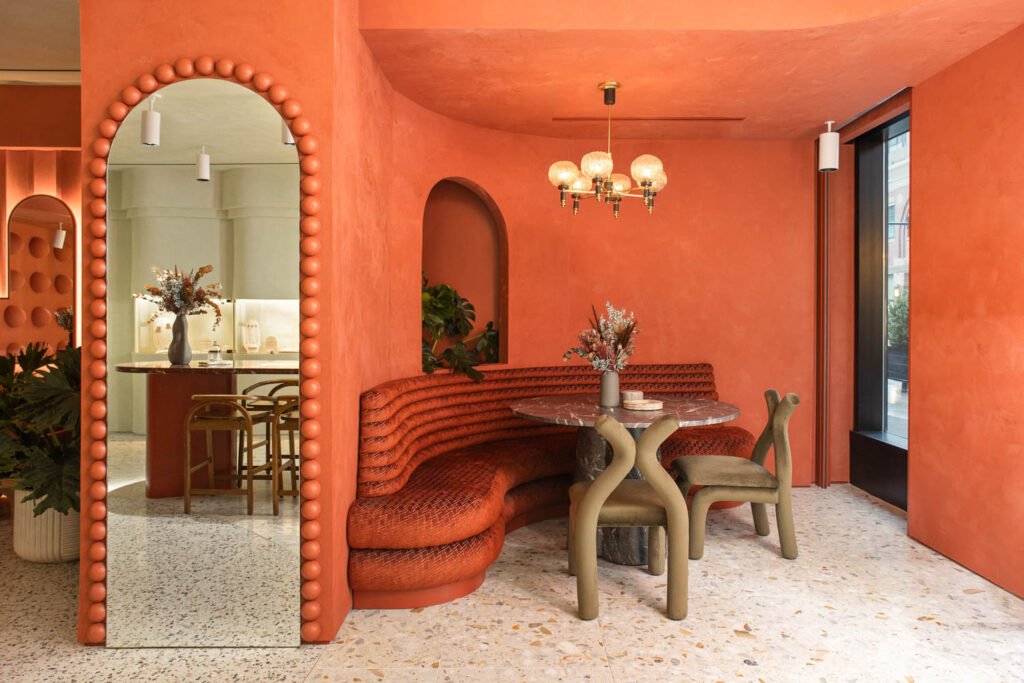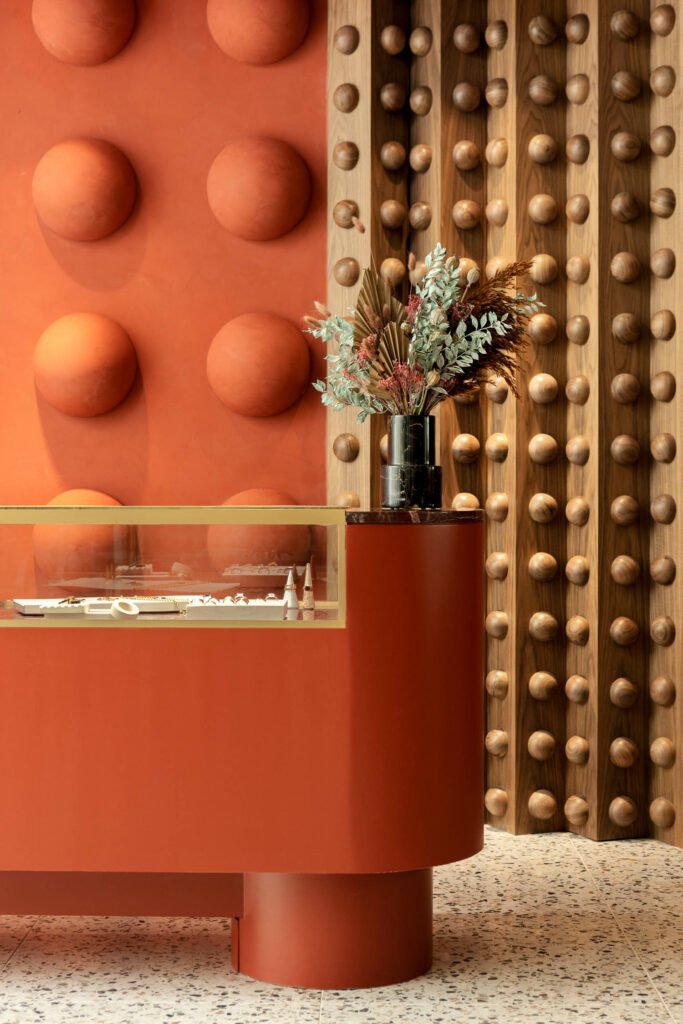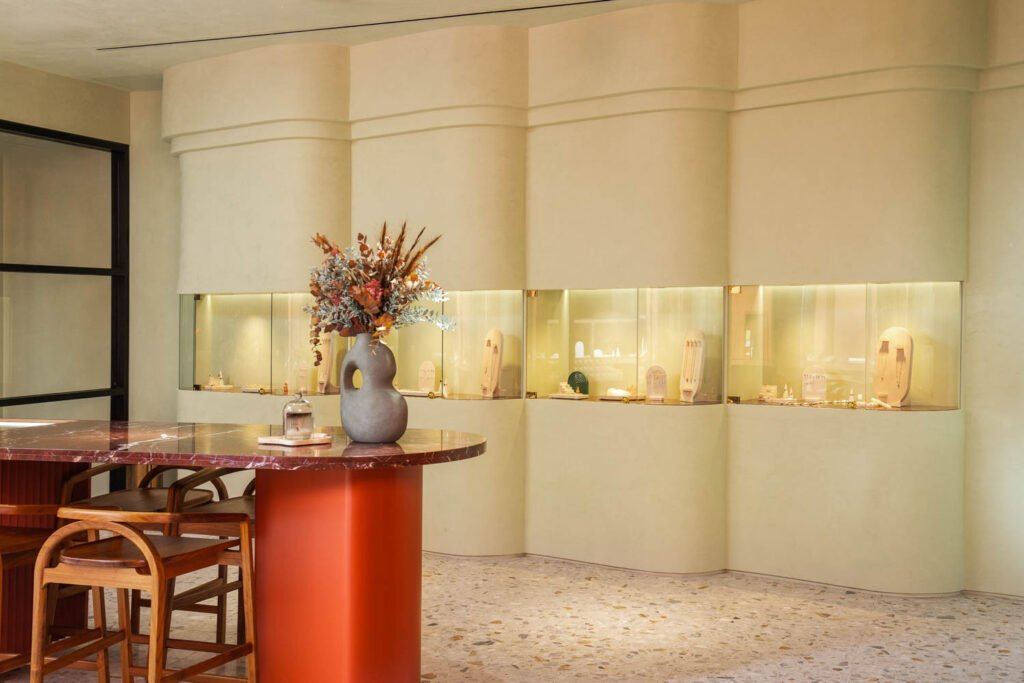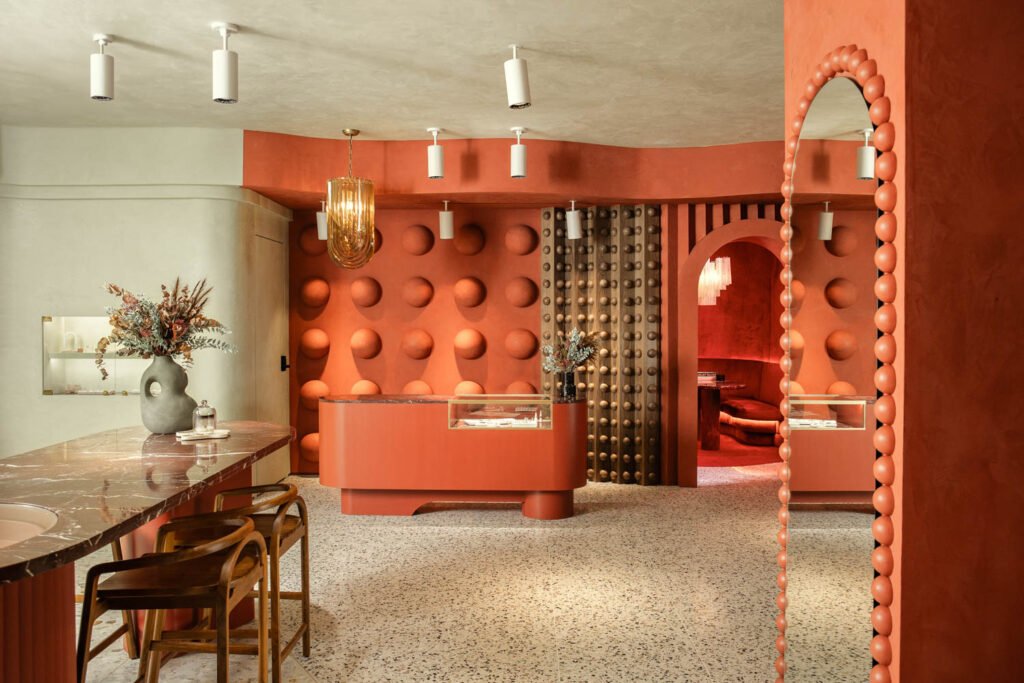Embarking on a jewelry shopping spree could be pretty daunting, particularity when it involves high value acquisitions. Picture this, sales representatives behind a counter of lavish trinkets, casting judgmental smiles as they evaluate prospects, quite an unwelcoming atmosphere, right? Not to worry, Barbara Rourke and Jason St. John, founders of LA-based Bells + Whistles studio, shatter this paradigm through their transformative design work at Marrow Fine’s third location in the heart of frenetic Chicago. Their playful yet classic design approach unveils a dusky, terracotta-toned haven, enveloped by mottled Venetian plaster grounded by a terrazzo flooring, a dramatic yet timeless atmosphere where customers can comfortably relax over a glass of champagne while browsing potential treasures. This inviting interior design sculpture, oscillating between a chic hotel lobby and a retail setting, echoes Marrow’s foundational ethos of brand storytelling and creating enriching experiences that their jewelry wearers cherish.
Incorporating Terra Cotta Hues into a Jewelry Store Decor
Incorporating color into interior decor is an essential key in creating the right ambiance for any store, especially when it comes to fine jewelry stores. ### Influential Role of Terra Cotta Hues Terra cotta hues play a significant role in breaking the typical intimidating atmosphere often associated with high-end jewelry shopping. The warm tones of terra cotta drive a sense of comfort and welcome, making customers feel homey and relaxed while they peruse precious baubles.
Creating a Luxurious Ambiance
Pairing these earthy hues with a luxurious design such as mottled Venetian plaster and terrazzo flooring forms an indulgent atmosphere that balances opulence with homeliness, enticing customers to spend more time—and potentially more money—in the store.
Maintaining a Timeless Appeal with Terra Cotta Hues
The use of timeless shades like the dusky terra-cotta tone creates a sophisticated backdrop that looks remarkable regardless of fashion trends, for years to come. This ensures the store maintains a fresh, stylish appeal, much like an emerald and diamond ring passed down as a cherished family heirloom.
Inspiration Drawn from the Location for the Store Design
Aligning Store Design with the Architechtural Milieu of Chicago
In designing a jewelry store, it is crucial to take inspiration from the surrounding area, especially when the location is as architecturally rich as Chicago. Integrating elements from local architecture can anchor the store to the city and allows the space to reflect the character of its surroundings.
Translating City Elements into Interior Design
The fine architectural details that adorn Chicago’s buildings, even hundreds of feet in the air, can be influential elements for a store’s interior design. Structures such as friezes are some of the many features that can be rendered into a store’s decor to resonate with the city’s character.
Creating a Distinctive Regional Aesthetic
In combining the local architectural elements with the store’s brand identity and design goals, you create a distinctive regional aesthetic. Drawing from a city like Chicago, known for its architectural excellence, can lend a unique, timeless quality to the store’s appearance that resonates with both local and visiting customers.

Strategic Placement of Seating Areas
Strategically Placing Seating Vignettes
Thoughtfully placed seating areas allow the clients to sit comfortably while they consider potential purchases. This could mean arranging a tiered sofa in embossed velvet near the entry or positioning a wood-framed settee flanked by plant recesses across the space.
Creating an Inviting and Relaxed Shopping Environment
Varied seating vignettes offering champagne flutes to the clients while they browse make the entire shopping experience akin to relaxing in a luxe hotel lobby rather than a conventional retail setting. This relaxed, indulgent atmosphere can make customers more comfortable and open to exploring high-ticket options.
Furnishing Choices for Comfort and Class
Opting for rich materials for your furnishings, such as velvet and marble, can add to the store’s luxurious feel while maintaining the comfort factor. Vintage Italian chandeliers or contemporary furniture, when harmoniously paired with the overall design, can enhance the store’s visual appeal, translating into an elevated shopping experience.
Creating a Versatile Customer Interaction Space
Movement and Interactivity within the Store
One crucial aspect of breaking the stagnation often associated with traditional jewelry shopping is encouraging movement within the store. Well-placed display fixtures and seating vignettes can incite the customers to walk around the store, enhancing their interaction with the space and your collections.
Display Cases Encouraging Movement
Display cases also play an essential role in encouraging movement. Cases should be designed and located in ways that draw customers through the store, introducing them to different collections as they move.
Private Spaces for Customer Consultations
Creating private spaces for more intimate customer consultations can also greatly lift the overall customer experience. A secluded salon clad floor-to-ceiling with crimson velvet, for instance, could offer an indulgent, private ambiance.

Role of Lighting in Jewelry Store Interiors
Strategic Use of Natural and Artificial Lighting
Lighting plays a pivotal role in highlighting your jewelry pieces and setting the mood for the store. Strategic use of both natural and artificial lighting can bring out the best in your products and create an inviting atmosphere.
Highlighting Product Displays with Dedicated Lighting
Dedicated lighting for product displays can make your jewelry stand out. Proper lighting can truly showcase the brilliance of your jewel pieces and draw customers in.
Creating a Warm and Inviting Atmosphere with Light
The use of warm toned lights can augment the warmth derived from the use of terra-cotta hues, generating an inviting and intimate atmosphere in the store. It helps set the mood and encourages customers to linger, browse, and shop.
Harmonizing the Store Design Elements
Incorporating Shapes and Forms in the Design
While color and lighting play significant roles in setting up a store’s vibe, the incorporation of shapes and forms also highly influences the store’s aesthetic. Choosing to integrate shapes like orbs, ovals, niches, and tambours adds depth and variety to the decor.
Balancing Color, Texture and Form
Striking the right balance between colors, textures, and forms is fundamental to achieving a cohesive interior narrative. While the color sets the mood, textures and forms, such as a scalloped citron-toned display wall with built-in vitrines, can bring variety and interest to the space.
Creating a Cohesive Interior Narrative
Each design element, from the color scheme to the seating arrangements and the shape of display cases, should work harmoniously to create a seamless, immersive story. The store’s design should be a journey that customers embark on, not just a backdrop.

Jewelry Display Techniques for Maximum Impact
Planning Effective Store Displays
The way you display your jewelry can significantly influence a customer’s impression and the item’s perceived value. Planning these displays thoughtfully can increase product appeal and make the shopping experience enjoyable for your customers.
Strategically Displaying High-Ticket Items
High-ticket items require special attention when it comes to displays. By strategically placing these items in high-visibility areas or using specialized display lighting, you can draw more attention to these pieces and increase their chances of purchase.
Experimenting with Non-traditional Display Methods
Don’t be afraid to experiment with non-traditional display methods. Display fixtures that mirror the store’s bold palette, or glassed-in end pieces for jewelry exhibits, can be innovative approaches that stand out to customers and enhance product examination.
Customer Experience as a Key Consideration in Store Design
Prioritizing Customer Comfort
Always remember that customer comfort should be a priority in store design. The store should not only be a space to house your collections but also an ambience where customers feel valued and comfortable.
Facilitating Easy Browsing
Design your store in a way that allows for easy browsing, with well-organized collections and clear display descriptions. Intuitive circulation on the shop floor can ensure your customers explore more and find the right piece effortlessly.
Offering a Unique and Memorable Shopping Experience
Ensure that your store layout, decor and customer service deliver a unique and memorable shopping experience. From personalised consultations to unique displays, every element contributes to the customer’s experience and influences their perception of your brand.

Incorporating Vintage Furniture for a Classic Feel
Choosing Vintage Chandeliers, Tables and Seating
Including vintage furniture, such as chandeliers, tables and seats, can lend a timeless, classic feel to your store. These pieces can make your space more visually appealing and can often serve as conversation starters.
Creating a Classic and Timeless Feel
Vintage furniture pieces have a charm and elegance that’s difficult to replicate, bringing an air of sophistication to your store decor. It’s a simple way to create a relaxed yet upscale atmosphere in your store.
Balancing Vintage with Modern Design Elements
While vintage furniture brings timeless elegance, balancing it with modern design elements ensures your store design remains relevant and relatable to a wide range of customers.
Creating a Store Design that Reflects the Brand’s Identity
Infusing Store Design with the Brand’s Story and Identity
Your store should tell your brand’s story. This could be reflected in the choice of colors, the type of jewelry displayed, the pictures on the wall or even the music playing in the background. Every facet of the store design should resonate with what the brand stands for.
Creating a Customer Experience in Line with Brand Values
Customer experience should be consistent with your brand’s values. If your brand values exclusivity, private consultation areas could be a key design element; if your brand stands for openness and accessibility, an open floor plan could more aptly communicate that.
Showcasing Jewelry in a Setting that Enhances its Value
Ultimately, the store should serve as the perfect backdrop to showcase your jewelry and enhance its perceived value. The layout, design, lighting, and display cases should all work together to frame your collections in the best light possible.
By taking into considerations like color, furniture, lighting, and brand identity, you can create an effective store design that not only appeals aesthetically–but also drives surefire results for your jewelry business.

